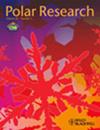北冰洋中部波浪-冰模型产品和漂移波浪浮标观测结果的比较:研究薄冰盖中海冰强迫的影响
IF 1.3
4区 地球科学
Q3 ECOLOGY
引用次数: 4
摘要
OpenMetBuoy的原型(OMB)被部署在北冰洋中部拉普捷夫海以北的商业浮标旁边,该地区历史上没有海浪观测数据。浮标间对比结果表明,OMB准确地测量了波浪高和周期,因此可以利用浮标数据研究波浪冰模型的可预测性。我们研究的第一个事件是两个浮标都观察到显著波高Hm0突然下降,这是由于风向从沿冰边缘转变为冰外风造成的。北冰洋波浪分析与预报波冰模式产品(ARC MFC)由于模型对冰舌的不准确表示而低估了Hm0。第二种情况是新冰形成时的冰上波事件。在这种情况下,ARC MFC波冰模型产品在很大程度上低估了顺风浮标Hm0。通过将ARC MFC海冰强迫与neXtSIM海冰模式产品进行比较,对模型海冰条件进行了检验,我们的分析表明,ARC MFC不能解决年轻冰和灰冰等冰类型(通常小于30 cm)的薄冰厚度分布问题。ARC MFC模型计算的波浪耗散率与海冰厚度有关,且高估了薄冰层下的波浪耗散;为了提高可预见性,需要海冰强迫来解析薄厚度分布。这项研究为更好地预测新冰形成时边缘冰带的波浪提供了观测见解。本文章由计算机程序翻译,如有差异,请以英文原文为准。
A comparison of an operational wave–ice model product and drifting wave buoy observation in the central Arctic Ocean: investigating the effect of sea-ice forcing in thin ice cover
A prototype OpenMetBuoy (OMB) was deployed alongside a commercial buoy in the central Arctic Ocean, north of the Laptev Sea, where there are historically no wave observations available. The inter-buoy comparison showed that the OMB measured wave heights and periods accurately, so the buoy data were used to study the predictability of a wave–ice model. The first event we studied was when both buoys observed a sudden decrease in significant wave heights Hm0, which was caused by the change of wind directions from along the ice edge to off-ice wind. The Arctic Ocean Wave Analysis and Forecast wave–ice model product (ARC MFC) underestimated the Hm0 on the account of the fetch being constrained by the inaccurate model representation of an ice tongue. The second case was an on-ice wave event as new ice formed. In this instance, the ARC MFC wave–ice model product largely underestimated the downwind buoy Hm0. Model sea-ice conditions were examined by comparing the ARC MFC sea-ice forcing with the neXtSIM sea-ice model product, and our analysis revealed the ARC MFC did not resolve thin ice thickness distribution for ice types like young and grey ice, typically less than 30 cm. The ARC MFC model’s wave dissipation rate has a sea-ice thickness dependence and overestimated wave dissipation in thin ice cover; sea-ice forcing that can resolve the thin thickness distribution is needed to improve the predictability. This study provides an observational insight into better predictions of waves in marginal ice zones when new ice forms.
求助全文
通过发布文献求助,成功后即可免费获取论文全文。
去求助
来源期刊

Polar Research
地学-地球科学综合
CiteScore
3.20
自引率
5.30%
发文量
22
审稿时长
>12 weeks
期刊介绍:
Since 1982, Polar Research has been the international, peer-reviewed journal of the Norwegian Polar Institute, Norway''s central institution for research, environmental monitoring and mapping of the polar regions. Aiming to promote the exchange of scientific knowledge about the Arctic and Antarctic across disciplinary boundaries, Polar Research serves an international community of researchers and managers. As an open-access journal, Polar Research makes its contents freely available to the general public.
Original primary research papers comprise the mainstay of Polar Research. Review articles, brief research notes, letters to the editor and book reviews are also included. Special issues are published from time to time.
The scope of Polar Research encompasses research in all scientific disciplines relevant to the polar regions. These include, but are not limited to, the subfields of biology, ecology, geology, oceanography, glaciology and atmospheric science. Submissions from the social sciences and those focusing on polar management and policy issues are welcome. Contributions about Antarctica are particularly encouraged.
 求助内容:
求助内容: 应助结果提醒方式:
应助结果提醒方式:


